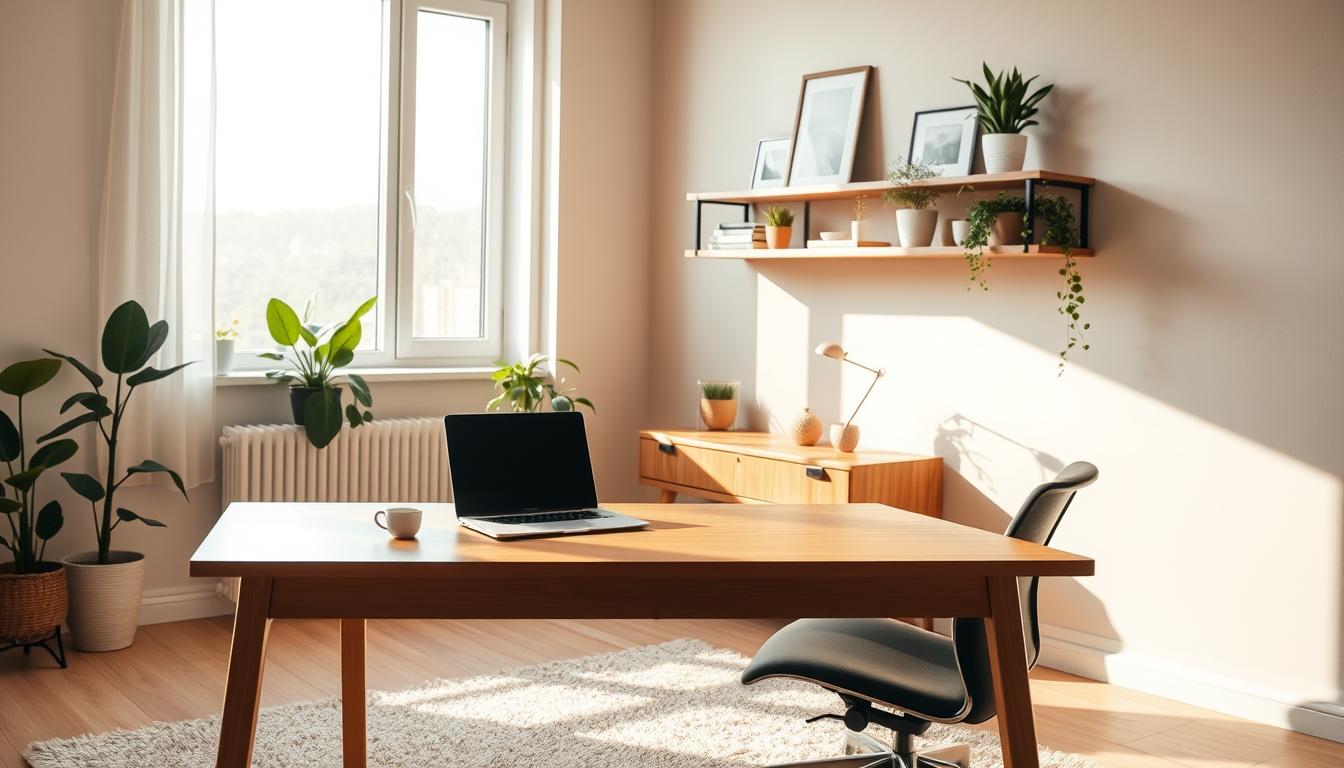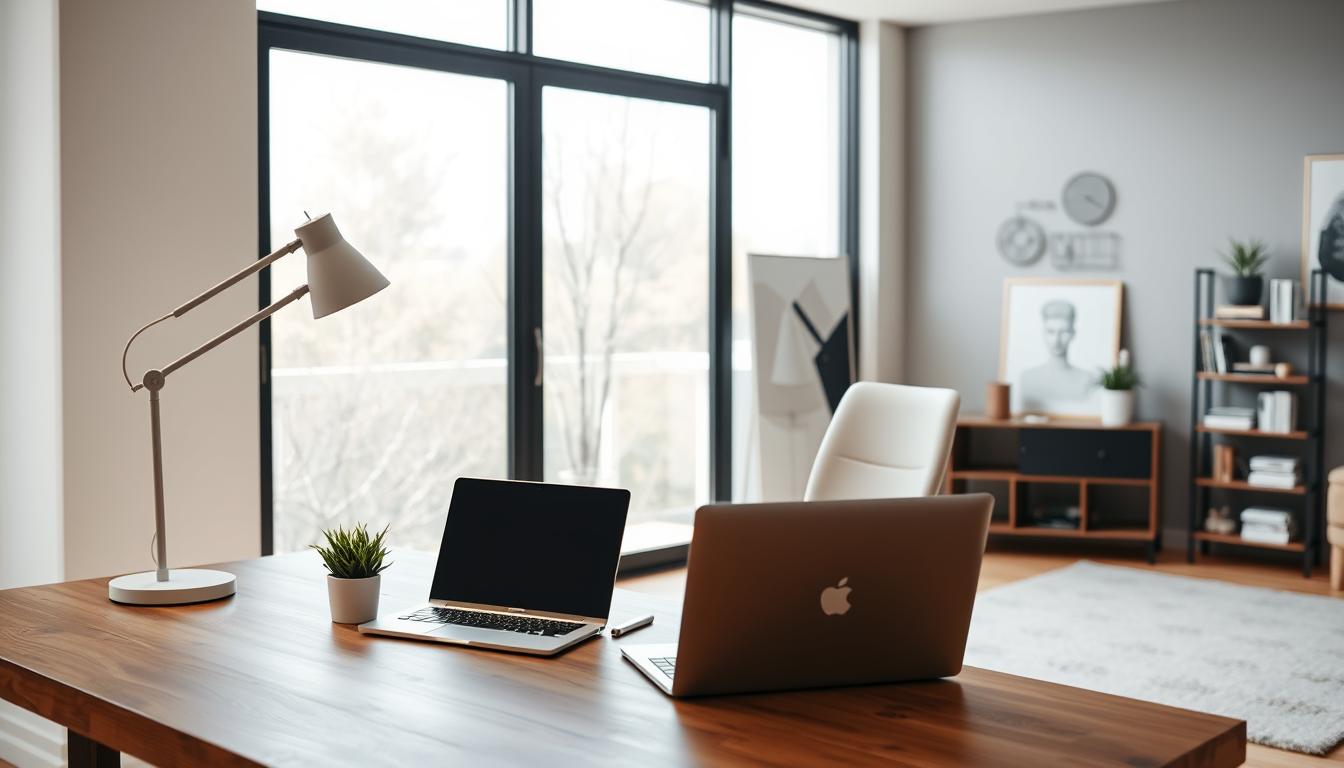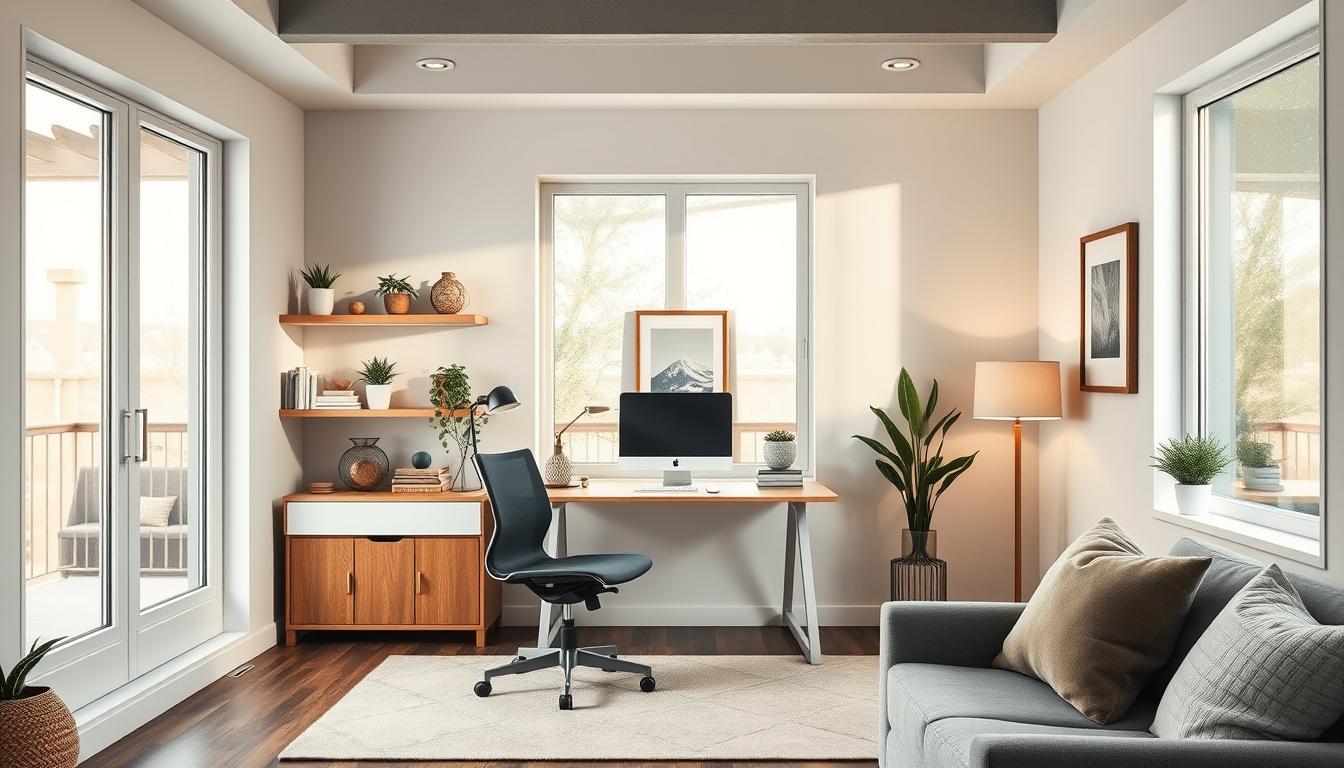Over 4.7 million Americans work from home at least half the time. This makes having a productive workspace more important than ever. A well-designed space can really help you work better, think more creatively, and enjoy your job more.
We’ll show you how to make your workspace both productive and stylish. You’ll get our best tips for a space that works well and looks good, tailored to your needs.
Key Takeaways
- Create a dedicated workspace to boost productivity
- Optimize your workspace for maximum efficiency
- Consider the importance of lighting and ergonomics
- Minimize distractions with effective noise management
- Incorporate plants for a healthier work environment
Creating an Effective Workspace Layout
An efficient home office layout is key to a productive work space. When designing your workspace, think about both function and comfort.
To get this right, we must focus on a few important things. First, we need to choose the right desk and chair. These are the heart of our workspace.
Choosing the Right Desk and Chair
Choosing the right desk and chair is crucial for comfort and productivity. An ergonomic office decor helps us work for long periods without getting tired.
When picking a desk, think about the size of your space and your work type. A big desk can hold multiple monitors and lots of papers.
For the chair, look for one that supports your back and adjusts to fit you. This ensures comfort.
Optimizing Space for Movement
A good workspace lets you move easily. This means having enough room between furniture and keeping things you use often within reach.
By making space for movement, we cut down on distractions. This boosts our work efficiency.
Incorporating Storage Solutions
Effective storage is essential for a clutter-free workspace. Using modern office furniture with storage, like drawers and shelves, keeps things organized.
Keeping our workspace clean helps us focus better. We work more efficiently when our space is tidy.
Selecting the Best Color Palette
The color palette of your home office is key to your productivity. A good color scheme can boost creativity, calmness, and focus. Think about how colors affect your mood and work.
Impact of Colors on Productivity
Colors can change how we feel and work. Blue brings calm and trust, perfect for focused tasks. Yellow sparks creativity and energy, great for brainstorming or art.
Here’s a list of colors and their effects on productivity:
- Red: Boosts alertness and energy, ideal for intense work.
- Green: Encourages balance and precision, good for detailed tasks.
- Orange: Fosters creativity and enthusiasm, perfect for new ideas.
Popular Color Choices for Home Offices
Choosing colors for your home office can boost productivity. Modern spaces often use neutrals like beige or light gray. Add vibrant colors for creativity.
For more ideas, check out our guide on stylish home office decor ideas. It offers tips on creating a beautiful and productive workspace.
Some top color combinations include:
- Monochromatic schemes for a unified look.
- Complementary colors for visual appeal.
- Analogous colors for a smooth palette.
Choosing the right color palette can make your home office more productive and comfortable.
Lighting: Natural and Artificial Options
A well-lit workspace boosts productivity and comfort. Lighting is key in home office design, affecting our work and well-being.
Maximizing Natural Light
Using natural light is vital for a healthy work space. It cuts down on artificial light needs and lifts our mood. To get more natural light, place your desk by a window. Use mirrors to bounce light and keep windows clear.
Tips for Maximizing Natural Light:
- Put your desk by a window for natural daylight.
- Use sheer curtains or blinds to control light.
- Don’t clutter windowsills to keep light flowing.
Types of Office Lighting Fixtures
Artificial lighting is also crucial for our workspace. There are many lighting options, like overhead lights, table lamps, and floor lamps. Each has its own use and helps create a layered lighting effect.
Some popular lighting options include:
- LED Desk Lamps: Energy-saving and adjustable, perfect for focused work.
- Floor Lamps: Offer ambient light and decorate the room.
- Recessed Lighting: Sleek and modern, great for overhead lighting.
Importance of Task Lighting
Task lighting is vital for tasks like reading, writing, or computer work. It helps reduce eye strain and boosts focus.
Benefits of Task Lighting:
- Reduces eye strain with focused light.
- Improves visibility for detailed tasks.
- Makes working more comfortable and productive.
By mixing natural and artificial light, and adding task lighting, we can make our home office bright and welcoming. This setup boosts productivity and comfort.
Personalizing Your Home Office Design
Making your home office your own can make it more inviting and useful. A well-designed office boosts productivity and shows off your style. It’s all about finding the right mix of personal touches and a professional feel.
Adding Personal Touches
Adding personal touches makes your office feel more like home. Think about adding things that inspire you, like artwork, family photos, or collectibles. These items can give your space character and make it truly yours.
Here are some ideas for adding personal touches:
- Displaying personal achievements or awards
- Incorporating plants or greenery to enhance mood
- Using colorful rugs or decorative items to add warmth
Balancing Professionalism and Comfort
It’s key to keep a professional vibe in your office, even with personal touches. This can be done by mixing decorative items with practical, modern furniture. A stylish office can boost your productivity and work experience.
To find this balance, consider these tips:
| Professional Elements | Personal Touches |
|---|---|
| Modern desk and ergonomic chair | Family photos or artwork |
| Efficient storage solutions | Decorative rugs or plants |
| Good lighting | Personal collectibles or achievements |
By blending these elements, you can create a space that’s both professional and cozy. For small offices, look to contemporary office furniture designs for inspiration. These designs are stylish and space-saving.
Incorporating Technology Effectively
Remote work has made using technology in our home offices crucial. We aim to make our home offices both productive and comfortable. This means setting up a functional home office layout that works well.
We focus on two main areas: the tech tools we need and creating an ergonomic space. These elements help us build a modern home office. It should look good and support our health.
Essential Tech Tools for Productivity
Today, the right tech is key in our digital workplaces. Some must-haves include:
- High-speed internet connectivity
- Reliable computers or laptops
- Noise-cancelling headphones
- Productivity software
- External monitors for multitasking
These tools help us work better and faster. For example, noise-cancelling headphones help us focus. Productivity software makes our tasks easier.
Setting Up an Ergonomic Workspace
An ergonomic office decor is about health and productivity, not just looks. To create a healthy workspace, follow these tips:
- Position your monitor directly in front of you, at a distance of about 20-25 inches.
- Keep your keyboard and mouse close to your body to avoid reaching forward.
- Adjust your chair height so that your feet are flat on the floor or on a footrest, with your knees at or below hip level.
By following these ergonomic tips, we can avoid discomfort and injury. This makes our work environment healthier and supports our productivity over time.
In summary, using technology well in our home offices means choosing the right tools and setting up an ergonomic space. This way, we can make a functional home office layout that boosts our productivity and work experience.
Maintaining a Clutter-Free Environment
A clutter-free workspace boosts focus and productivity. An organized home office lets you work better and faster. We’ll share tips and strategies to keep your space tidy.
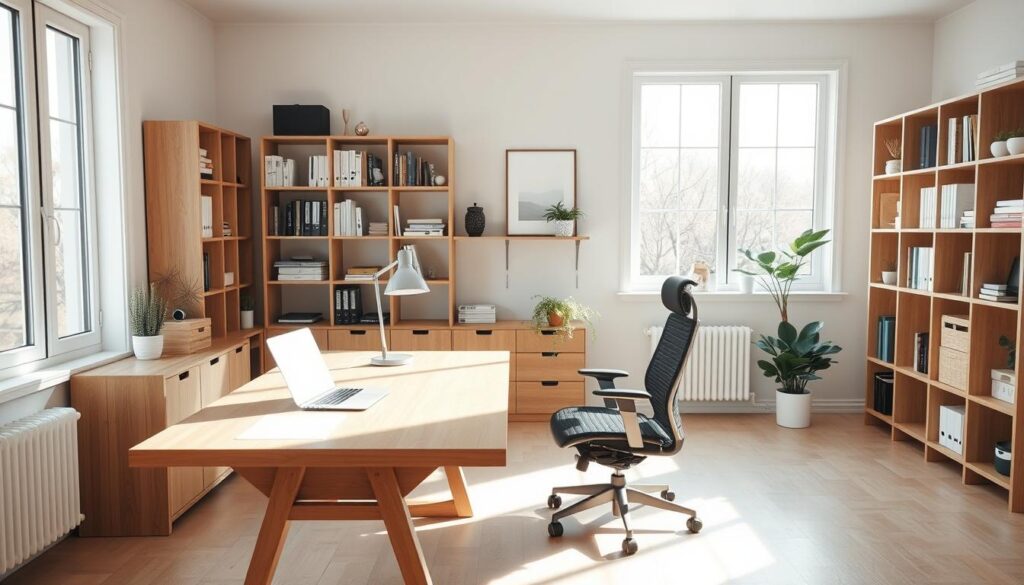
Organizational Tips for Office Supplies
Managing office supplies is key to a tidy home office. Use contemporary office furniture with drawers and shelves. Labeling your storage makes finding items easy.
Organize supplies by type, like pens, papers, and folders. This makes finding what you need simple.
Decluttering Strategies for Focus
Regularly decluttering your home office is crucial. Remove items you don’t need or use. Choose best home office designs for a clean look, like minimalist decor and lots of storage.
To stay focused, reduce distractions. Make your workspace quiet and comfy. Use noise-reducing materials or a white noise machine for the perfect work spot.
Follow these tips and strategies for an organized home office space. It will boost your productivity and focus.
Choosing Functional Office Decor
The right office decor can make our work space more inviting and efficient. A well-designed workspace boosts our mood and productivity. Let’s look at how to pick the perfect decor for our home office.
Art and Greenery to Enhance Mood
Adding art and greenery to our home office can greatly improve our well-being. Art adds a personal touch, and plants purify the air and reduce stress. Try adding art that inspires you or some greenery like succulents to create a calm atmosphere.
Benefits of Greenery:
- Improves air quality
- Reduces stress levels
- Boosts creativity
When picking art, choose pieces that inspire you or show your style. For greenery, pick low-maintenance plants that fit your lifestyle.
Practical Decor Ideas
For a stylish workspace, consider practical decor ideas. Here are a few suggestions:
- Use decorative storage bins to keep office supplies organized.
- Incorporate a statement piece of furniture that reflects your personal style.
- Add a rug to define the workspace and add warmth underfoot.
For small home office inspiration, think vertically. Use wall-mounted shelves and storage units to maximize space. Also, consider multi-functional furniture pieces, like a desk with built-in storage.
“A cluttered space can lead to a cluttered mind. Keeping your workspace organized and clutter-free is essential for productivity.”
By choosing functional office decor that looks good and works well, we can create a home office that’s both beautiful and productive.
Establishing Work-Life Boundaries
When your home office is close, it’s easy for work and personal life to mix. It’s key to set boundaries to keep them separate. This helps you balance work and personal life better and boosts productivity.
Defining Your Office Hours
Setting office hours is crucial to separate work from personal time. A regular schedule helps you and your family. Make sure to tell your family and colleagues about your hours so everyone knows when you’re working.
To set good office hours, think about these steps:
- Find out when you work best
- Set achievable goals and deadlines
- Include regular breaks in your routine
This way, you can make a schedule that fits your work style and keeps you focused.
Creating a Separate Work Zone
Having a separate work area is key to keeping work and personal life apart. Choose a specific spot in your home for your office and keep it tidy. A well-organized home office helps you stay on track and avoid distractions.
| Benefits of a Separate Work Zone | Tips for Creating a Separate Work Zone |
|---|---|
| Improved focus and productivity | Designate a specific area for your office |
| Reduced distractions and interruptions | Keep your office organized and clutter-free |
| Enhanced work-life balance | Establish a routine that includes regular breaks |
A cluttered space can make your mind cluttered too. An organized workspace helps you stay focused. By having a separate work area, you can better separate work from personal life. This leads to more productivity and a better balance between work and life.
“The way we spend our time defines who we are, and our workspace is a reflection of our priorities.”
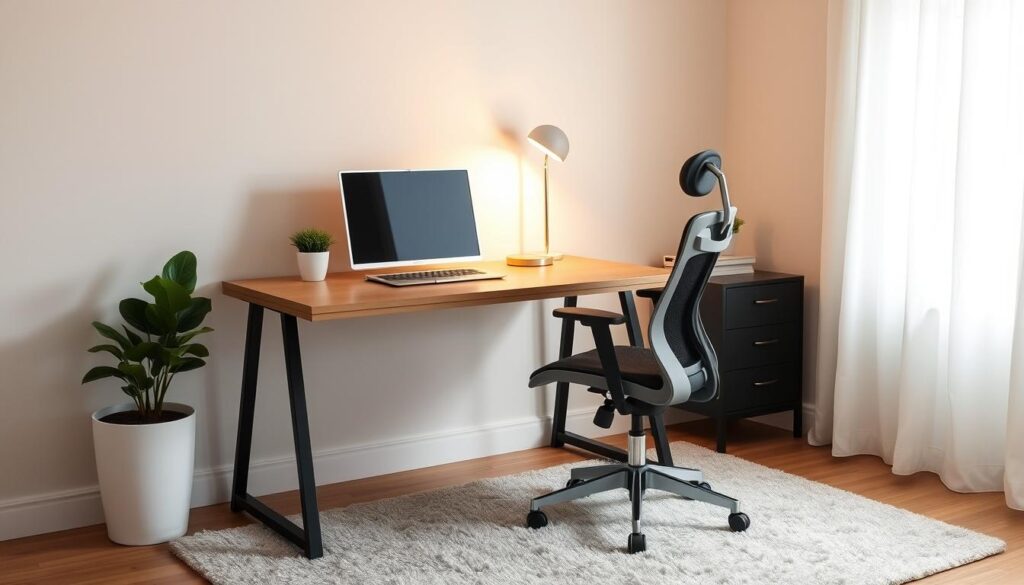
Enhancing Acoustics for Better Focus
To improve your focus, it’s key to think about your workspace’s acoustics. The sound in your home office greatly affects your productivity and ability to concentrate.
Soundproofing Our Office Space
Soundproofing is vital for a productive home office. It helps block out external noise and keeps internal sounds from distracting you. Here are some ways to soundproof your office:
- Use thick, heavy curtains or drapes to reduce outside noise.
- Install acoustic panels on walls and ceilings to absorb sound.
- Seal gaps and cracks around doors and windows to prevent sound leakage.
- Consider using a soundproofing blanket or acoustic insulation in walls.
These steps can make your home office quieter and more organized, boosting your productivity.
Using White Noise Machines
White noise machines are also great for improving your office’s acoustics. They create a constant, calming sound that covers up background noises. This helps you stay focused.
| Benefits of White Noise Machines | Features to Consider |
|---|---|
| Improved concentration | Variety of sound options |
| Reduced distractions | Adjustable volume control |
| Enhanced relaxation | Portability and compact design |
When picking a white noise machine, look at the sounds it offers, its volume control, and design. Adding a white noise machine to your best home office designs can really boost your productivity.
By using soundproofing and white noise machines, you can make a modern office that meets your work needs. It also helps keep your home office space organized.
Updating and Refreshing Our Workspace
Working from home can make our workspace feel old and dull. It’s important to keep it looking good and working well. This keeps our home office fresh and stylish.
Refresh Time
Knowing when to redecorate is key. If your space is cluttered or outdated, it’s time for a change. Think about the layout, lighting, and feel to make it better.
Seasonal Tweaks
Seasonal changes are a great time to update your workspace. Try adding seasonal colors or decor to keep it fresh. Check out estilolepa.com for stylish ideas.
Making small changes can greatly improve your home office. Whether it’s new artwork or rearranging furniture, updates are important. They can greatly enhance your work experience.
